Muslin trade in Bengal
Muslin, a cotton fabric of plain weave, was hand woven in the region around Dhaka, Bengal (now Bangladesh), and exported to Europe, the Middle East, and other markets, for much of the 17th and 18th centuries.[1]
Origins
Bengal has manufactured textiles for many centuries, as recorded in ancient hand-written and printed documents. The Periplus of the Erythraean Sea mentions Arab and Greek merchants trading between India and the Red Sea port of Aduli (in present-day Eritrea), Egypt and Ethiopia in the second century CE. Cloths including muslin were exchanged for ivory, tortoiseshell and rhinoceros-horn at that time. Muslin was traded from Barygaza – an ancient port of India located in Gujarat – to different parts of Indian subcontinent before European merchants came to India.[2]
The Romans prized muslin highly, using bullion and gold coins to buy the material from Deccan and South India.[2] They introduced muslin into Europe, and eventually it became very popular.[3] A Chinese voyager, Ma Huan, wrote about five or six varieties of fine cloths after visiting Bengal in the early fifteenth century; he mentions that Bengal muslin was highly priced in China at that time.[2]
Mughal era

Under Mughal rule, Bengal was a center of the worldwide muslin, silk and pearl trades.[4] During the Mughal era, the most important center of cotton production was Bengal, particularly around its capital city of Dhaka, leading to muslin being called "daka" in distant markets such as Central Asia.[5] Bengal also exported cotton and silk textiles to markets such as Europe, Indonesia and Japan.[6] Bengal produced more than 50% of textiles and around 80% of silks imported by the Dutch from Asia, for example.[7]
Sixteenth century
In the early sixteenth century, a Portuguese apothecary named Tomes Pires mentioned that Bengal muslins were traded to Thailand and China.[2] Bengali muslin was also traded throughout the Muslim world, from the Middle East to Southeast Asia.[3] By 1580, some Portuguese traders settled at Dhaka and Sripur, from where they started exporting muslin, cotton and silk goods to Europe and Southeast Asia. [8]
During Ottoman rule from the sixteenth century onwards, large quantities of muslin was exported to the Middle East. Muslin turbans were favoured by the Ottomans. In the sixteenth century, Portuguese started trading textiles from the Indian subcontinent through the Persian Gulf including high quality of muslins. In the seventeenth century, the Portuguese trade declined.[9]
Seventeenth century
In the early seventeenth century, British and Dutch merchants arrived at the Indian Subcontinent sailing via the Red Sea. At the same time, Armenian merchants from Iran came to the Indian subcontinent travelling on land through Qandahar and Isfahan. They traded textile goods including muslin from Bengal to Aleppo of Syria. In an official inventory of Istanbul market dated from 1640, 20 types of muslins were found and the highest value found there is 1600 silver pence.[9] As the business expanded, European companies became interested in founding their own factories in Dhaka. The Dutch made their factory in Dhaka in 1663, the British in 1669 and the French in 1682.[10]
Eighteenth century
The Ostend Company came to Bengal at the beginning of the eighteenth century. They purchased textiles through agents and their own officials. When they found the business very profitable, they also made settlements in Dhaka.
Available statistics show that in 1747 the trade of Dhaka cotton goods (primarily Muslin), including local trade valued twenty-eight and a half lakh rupees.[10]
Decline
Bengal was conquered by the British East India Company after the Battle of Plassey in 1757 and the British Bengal Presidency was founded in 1765. British colonization forced open the Bengali market to British goods, while at the same time Britain implemented protectionist policies such as bans and high tariffs that restricted Bengali imports to Britain. Raw cotton was also imported without taxes or tariffs to British factories, which used them to manufacture textiles, many of which were exported back to Bengal. British economic policies led to deindustrialization in Bengal.[11][12][13] British colonization was also followed by the Great Bengal famine of 1770, which killed a third of the Bengali population.[14]
From 1787 to 1788, Dhaka suffered from severe natural calamities - especially heavy rainfall - and famine broke out. After the disaster, more emphasis was given on agriculture to reduce the effects of the famine. Tax was revoked on the exportation of grains. So, people became more interested in agricultural works than weaving as the wages of labourers and other people working in agriculture suddenly rose.[15]
From 1782 to 1787 the industrial revolution began in Britain, and fine cotton was produced locally. During British colonial rule, the muslin industry declined due to various colonial policies, which supported imports of industrially manufactured textiles from Britain.[3] A heavy duty of 75 percent was imposed on export of cotton from Bengal. These measures ultimately lead to the decline of muslin trade in Bengal.[15]
In 1811, Bengal was still a major exporter of cotton cloth to the Americas and the Indian Ocean. However, Bengali exports declined over the course of the early 19th century, as British imports to Bengal increased, from 25% in 1811 to 93% in 1840.[16]
Notes
- Ahmedullah, M, From Muslin To Museum: The Rise and Fall of Bengal’s Textile Empire-1,2 & 3, Alochonaa (Dialogue)
References
- "Muslin", Encyclopædia Britannica
- Ashmore, Sonia (2012). Muslin (Sonia Ashmore), Page 11. V&A Publishing. ISBN 9781851777143.
- Naushad, Naveed (15 December 2015). "The Muslin Story". The Daily Star. Retrieved 4 April 2017.
A favourite of the Romans, muslin was sought by merchants of the Roman empire and subsequently reached other parts of Europe.
- Lawrence B. Lesser. "Historical Perspective". A Country Study: Bangladesh (James Heitzman and Robert Worden, editors). Library of Congress Federal Research Division (September 1988). This article incorporates text from this source, which is in the public domain.About the Country Studies / Area Handbooks Program: Country Studies - Federal Research Division, Library of Congress
- Richard Maxwell Eaton (1996), The Rise of Islam and the Bengal Frontier, 1204-1760, page 202, University of California Press
- John F. Richards (1995), The Mughal Empire, page 202, Cambridge University Press
- Om Prakash, "Empire, Mughal", History of World Trade Since 1450, edited by John J. McCusker, vol. 1, Macmillan Reference USA, 2006, pp. 237-240, World History in Context. Retrieved 3 August 2017
- The Portuguese, Banglapedia
- Ashmore, Sonia (2012). Muslin (Sonia Ashmore), Page 12. V&A Publishing. p. 12. ISBN 9781851777143.
- Sarker, Md. Fouad Hossain. "History of Muslin Fabrics of Dhaka". Daffodil International University. Retrieved 24 July 2016.
- James Cypher (2014). The Process of Economic Development. Routledge. ISBN 9781136168284.
- Junie T. Tong (2016), Finance and Society in 21st Century China: Chinese Culture Versus Western Markets, page 151, CRC Press
- Broadberry, Stephen; Gupta, Bishnupriya (2005). "Cotton textiles and the great divergence: Lancashire, India and shifting competitive advantage, 1600-1850" (PDF). International Institute of Social History. Department of Economics, University of Warwick. Retrieved 5 December 2016.
- Kumar, Dharma; Desai, Meghnad, eds. (1983). The Cambridge Economic History of India. Volume 2: c. 1751-c. 1970. Cambridge University Press. p. 299. ISBN 978-0-521-22802-2.
- Taylor, James (1840). A Sketch of the Topography and Statistics of Dacca. Calcutta: G.H. Huttmann, Military Orphan Press. pp. 301–307.
- Giorgio Riello, Tirthankar Roy (2009). How India Clothed the World: The World of South Asian Textiles, 1500-1850. Brill Publishers. p. 174. ISBN 9789047429975.
Further reading
- Allen, B.C. (2009). Dacca : Eastern Bengal District Gazetteers. Delhi: LOGOS Press. ISBN 978-81-7268-194-4.
- Khan, Muhammad Mojlum (2013). The Muslim Heritage of Bengal. Kube Publishing. ISBN 978-1-84774-062-5.
- Asher, Catherine B.; Talbot, Cynthia (2006). India Before Europe. Cambridge University Press. pp. 281–. ISBN 978-0-521-80904-7.
- Eaton, Richard M. (1996). The Rise of Islam and the Bengal Frontier, 1204–1760. University of California Press. pp. 202–. ISBN 978-0-520-20507-9.
- Islam, Khademul (May–June 2016), Our Story of Dhaka Muslin, 67, AramcoWorld, pp. 26–32, OCLC 895830331
- Prakash, Om (1998). European Commercial Enterprise in Pre-Colonial India. Cambridge University Press. pp. 202–. ISBN 978-0-521-25758-9.
- Giorgio Riello; Prasannan Parthasarathi, eds. (2011). The Spinning World: A Global History of Cotton Textiles, 1200–1850. Oxford University Press. ISBN 978-0-19-969616-1.
- Giorgio Riello; Tirthankar Roy, eds. (2009). How India Clothed the World: The World of South Asian Textiles, 1500–1850. BRILL. pp. 219–. ISBN 90-04-17653-5.
- Staples, Kathleen A.; Shaw, Madelyn C. (2013). Clothing Through American History: The British Colonial Era. ABC-CLIO. pp. 96–. ISBN 978-0-313-08460-7.

'.jpg)